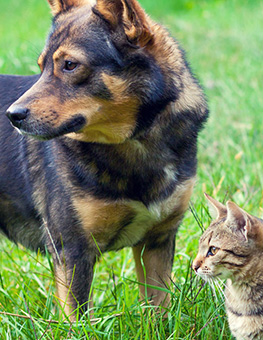Health Concerns Caused by Ticks
Ticks are dangerous parasites. They can carry multiple diseases that can be very harmful to your cat. Get the facts and learn how to protect yourself and your pet.
Lyme disease
Lyme disease is probably the most recognizable tick-borne disease. It is caused by a bacterium which is transmitted to humans and pets when the tick feeds. Ticks that carry Lyme disease are very small; in fact, they are no bigger than a pinhead during their immature stages.
Symptoms to look for:
- Joint pain
- Lameness
- Fever
If you suspect your cat has been bitten and may have Lyme disease, consult your veterinarian for diagnosis and treatment.
Rocky Mountain Spotted Fever
This disease (mostly common in dogs) is transmitted through the bite of the American dog tick and is most prevalent in the east coast, midwest, and plains regions. Signs of the disease appear in 2 - 14 days after tick attachment and can be severe.
Symptoms to look for:
- Loss of appetite
- Fever
- Depression
- Painful muscles and joints
- Swollen lymph nodes
- Swelling of the face and legs
- Vomiting
- Diarrhea
This disease can be diagnosed and treated by your veterinarian.
Ehrlichiosis
Ehrlichiosis is actually a group of diseases caused by several bacteria in the same family. Different strains of the disease can be transmitted by the Brown Dog Tick and Lone Star Tick when the ticks feed. The clinical signs vary depending on which phase of the disease your cat is displaying and can range from mild to very severe. Some cats display no signs of the disease at all.
Symptoms to look for:
- Listlessness
- Enlarged lymph nodes
- Fever
- Joint pain
- Anemia
- Abnormal bleeding
- Uveitis (inflammation of the eye)
- Kidney failure
Ehrlichiosis can be diagnosed and treated by your veterinarian.
Other tick-borne diseases
Hepatozoon Canis (rare on cats)is a one-celled parasite transmitted by the Brown Dog Tick. This disease is seen all year - not just during tick season. Most infections do not cause illness, but can spark serious consequences in pets already infected with diseases such as ehrlichiosis and those with suppressed immune systems. Symptoms to look for:
- Fever
- Weight loss
- Loss of appetite
- Nasal discharge
- Weakness of the hind limbs
- Anemia
- Bloody diarrhea
- Lameness
- Severe muscle pain
Canine Babesiosisis
a one-celled parasite that can infect cats. Clinical signs of infection include severe anemia. The severity of signs may vary depending on the strain of parasite, the level of infection, and your cat’s immune status. Also, if your cat has a concurrent infection, the signs may be worse.
Symptoms to look for:
- Anemia
- Loss of appetite
- Weight loss
- Fever
- Vomiting
- Diarrhea
- Kidney failure
Haemobartonellosis
Haemobartonellosis (also known as feline infectious anemia) is a tick- and sometimes flea-transmitted disease. Your cat can also spread the disease to her kittens and to other cats through bites. Signs of this disease can range from mild to very severe and some cats can recover from the disease but still be carriers.
Symptoms to look for:
- Anemia
- Depression
- Loss of appetite
- Weight loss
- Weakness
- Fast respiratory rates
- Jaundice
- Sudden death
Haemobartonellosis can be diagnosed and treated by your veterinarian.
Practice prevention
As with all diseases transmitted by ticks, tick control is the key to prevention. Products which repel and kill ticks such as those found in the Hartz® UltraGuard PRO® and Hartz® UltraGuard Plus™ lines are preferred choices.



















